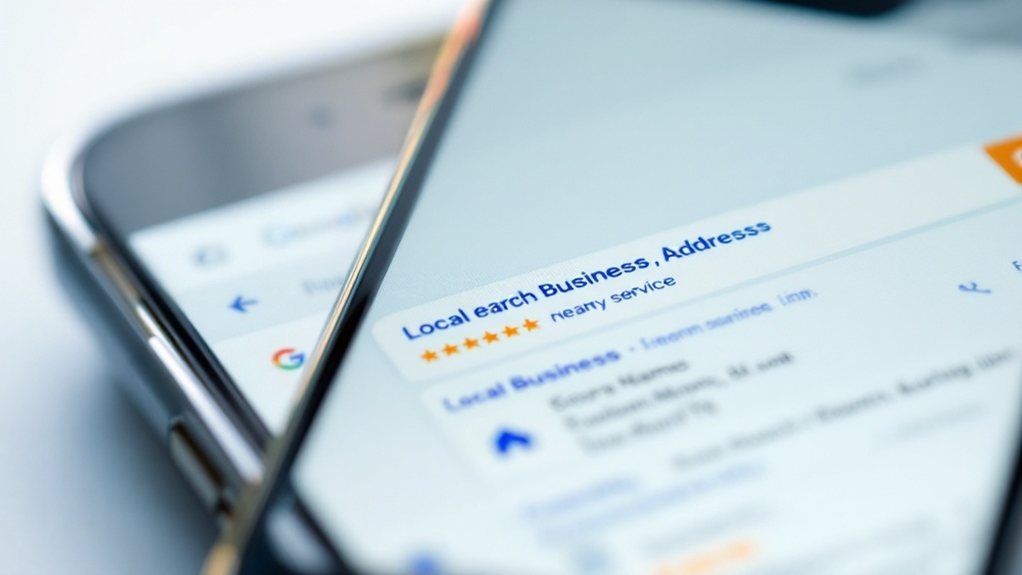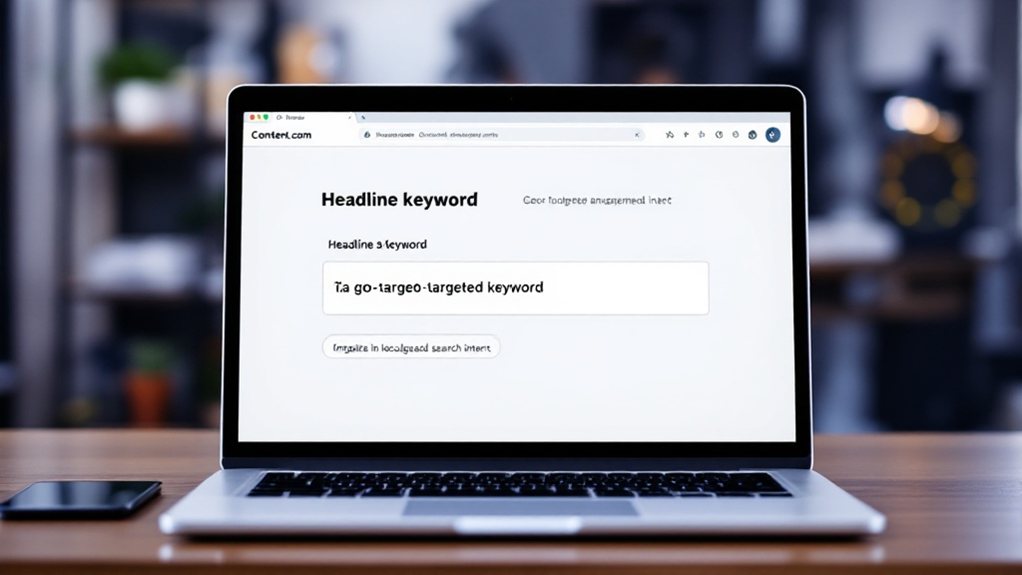Optimize your headlines for local search intent by incorporating geo-targeted keywords that align with hyper-local trends. Leverage long-tail phrases to address your audience's specific needs and cultural nuances. Craft compelling meta descriptions that resonate with your community. Prioritize proximity-driven searches and mobile-friendly optimization to boost your local visibility. By strategically aligning your headlines with local search, you'll enhance your search presence and drive high-converting traffic. Keep reading to discover more advanced local SEO tactics.
Understanding the Power of Local Search

Nearly half of all Google searches have local intent, underscoring the power of local search for businesses. With 80% of local searches converting into calls, visits, or sales, and 21% of consumers searching for nearby businesses daily, optimizing for local search can significantly impact your bottom line. Positive reviews can boost this impact, as 75% of consumers rely on online reviews to research local companies, and 88% of those who search on smartphones visit or call a store within a day. Leveraging Google's dominance in local search, with 66% of users trusting it for business information and 88% using Google Maps, is crucial for driving traffic and conversions. Furthermore, 32% of people have admitted to using AI for local business searches, indicating the growing importance of integrating AI-powered tools into local SEO strategies.
Incorporating Geo-Targeted Keywords in Headlines

Honing your headlines with geo-targeted keywords can significantly boost local search visibility. By aligning your content with hyper-local search trends, you'll attract highly relevant traffic and earn trust through demonstrated expertise. Utilizing location-specific terms can help you tailor your messaging to resonate with your target audience for maximum impact. Incorporating nearby suburbs or specific neighborhoods as geo-targeted keywords can further enhance your local branding and visibility.
Leveraging Location-Based Keywords
When optimizing headlines for local search, leveraging location-based keywords is crucial. Location pages can help increase the chances of appearing in local Google search results. Geo-targeting approaches like using location insertion in Google Ads can dynamically include city or state names. Incorporate geo-targeted keywords in ads and web content to attract location-specific searches. Develop location-specific keyword strategies for each area and utilize tools like Semrush to research local keywords and optimize SEO. Create templates with geographic placeholders for efficient content creation. Identify relevant location keywords by using research techniques to find explicit and implicit local keywords, filtering by search volume and difficulty, and analyzing competitor rankings. Monitor performance of location-based keywords in headlines and continuously update and enhance location-based content based on data-driven insights.
Tailoring Headlines for Local Relevance
As search engines increasingly prioritize personalized results, particularly for location-based queries, tailoring headlines for local relevance becomes paramount. Understanding your audience's search intent and incorporating geo-targeted keywords can provide a competitive edge. Mentioning specific cities, neighborhoods, landmarks, or regional nicknames can attract relevant local traffic. Strategically place these location-based terms in your title tags, meta descriptions, and headings to signal local authority. Crafting headlines that resonate with your community's unique culture and traditions can further strengthen your local branding. By leveraging the power of geo-targeted keywords, you can enhance your search visibility and appeal to your target audience's needs. [Optimizing headlines for local search intent is crucial for capturing location-based leads and establishing your business as a trusted community resource.
Optimizing for Proximity-Driven Searches
In the age of hyper-personalized search results, optimizing your headlines for proximity-driven queries is a must. Integrating location-based keywords seamlessly into your headlines can significantly enhance your visibility in local search results. Proximity search is a key ranking factor for Google. Remember to:
- Balance content flow by strategically placing geo-targeted keywords without compromising readability.
- Craft compelling meta descriptions that align with local search intent and complement your headline.
- Stay attuned to cultural and linguistic nuances, especially in multilingual environments, to ensure your headlines resonate with your target audience.
Leveraging Long-Tail Keyword Phrases

Beyond broad keywords, leverage long-tail phrases to target more specific local searches. These detailed queries attract highly relevant traffic and face less competition. Over 70% of search queries use long tail keywords, so craft long-tail headlines that align with your audience's search intent and your local business offerings. Doing so can help you capitalize on the prevalent use of long-tail keywords, especially with the rise of voice search and natural language queries.
Identify Relevant Keywords
Leveraging long-tail keyword phrases is crucial in identifying relevant keywords for your local search optimization efforts. By analyzing user search intent, you can uncover long-tail keywords that target specific geographical areas or niche interests. Long-tail keywords have lower search volume but less competition. Tools like Google Keyword Planner and SEMrush can help reveal:
- Relevant long-tail keywords with lower competition and higher conversion potential
- Question-based long-tail queries that address common customer pain points
- Location-specific long-tail phrases that improve local visibility
Craft Targeted Phrases
When crafting targeted phrases, you should leverage the power of long-tail keyword research. Long-tail keywords are more specific, often three or more words, and can help you attract highly relevant traffic. These targeted phrases align with advanced stages of the buyer's journey and mimic natural voice search patterns, enhancing your content's relevance. By utilizing tools like Google Keyword Planner, you can identify long-tail keywords with lower competition and higher conversion potential. Long-tail keywords can be used for voice search. Combining location-specific terms can further boost your local visibility. Additionally, incorporating question-based long-tail keywords can improve your content's ability to address user intent. Optimizing your headlines and content with these targeted phrases is crucial for effective local search engine optimization.
Optimize for Local Intent
Optimizing for local intent is crucial for businesses seeking to capture high-intent traffic within a specific geographic area. By leveraging long-tail keyword phrases, you can improve your website's visibility and relevance in local searches. Consider these strategies:
- Incorporate location-specific keywords in your headlines to signal local relevance. This helps search engines understand the geographic focus of your content.
- Utilize long-tail keywords that combine location with specific service terms, such as "plumbers in Chicago." These less competitive phrases can lead to higher conversion rates.
- Create location-based content that highlights local events, attractions, and news to strengthen your connection with the local audience and boost your local SEO. Optimizing for local search intent can significantly increase a business's chances of attracting more local customers.
Optimizing for Commercial and Transactional Intent
How can you optimize your title tags to effectively capture commercial and transactional intent? Include your main offerings and services to boost visibility and clarify your business focus. Incorporate local areas to enhance search ranking, and utilize key queries to improve traffic and performance. Highlight your unique selling points to differentiate your business and attract specific customers. Add a strong call-to-action to increase conversions and user engagement. For transactional intent, use phrases like "buy," "order," or "book" to signal direct purchase options. Location-specific phrases like "near me" can also attract users with immediate buying intent, improving visibility in local search results. Location-specific phrases like "near me" can also attract users with immediate buying intent, improving visibility in local search results.
Crafting Navigational Clarity in Headlines
Crafting navigational clarity in your headlines is crucial for guiding users to your business. Keep your headlines simple and direct, conveying the essence of your offering concisely. This will help users quickly identify your location and services, making it effortless for them to find and engage with your brand.
Simplicity for Easy Navigation
Clear and concise headlines are the cornerstone of effortless navigation. Keep your headlines short, ideally under 60 characters, for better visibility. Incorporate specific keywords that align with local search intent, such as "Dallas plumber," to guide users directly to the information they need. Structure your headlines to smoothly direct users to subsequent information, using action words like "Find" or "Discover" to create a clear call-to-action.
- Maintain a consistent tone and style across all headlines.
- Ensure headlines clearly convey what the content offers.
- Mention nearby landmarks to enhance geographical clarity.
Direct Messaging for Clarity
Direct messaging through carefully crafted headlines is the key to navigational clarity. Highlight your business name prominently to aid users searching for specific locations. Incorporate partial or full addresses to help users find you. Use directional phrases like "near downtown" to guide them. Referencing well-known local landmarks orients users, while mentioning community involvement builds local relevance. Optimize for mobile devices by ensuring headlines are clear and readable. By focusing on direct and actionable information, you can create headlines that effectively guide users to your local business.
Concise Phrasing, Optimal Length
When crafting headlines for local search, conciseness is key. Aim for fewer than 60 characters to ensure visibility in search results and use active voice to make your headlines more engaging. Additionally, include relevant local keywords like city names or phrases to enhance clarity and local intent. Remember, your headline should clearly reflect the search query, whether it's informational or transactional.
- Use simple, straightforward language to avoid confusion and improve clarity.
- Ensure your headline has a high keyword density for search engines to understand the context easily.
- Incorporate dynamic keywords that automatically update based on search queries, enhancing relevance.
Catering to Informational Search Queries
How can you cater to informational search queries to drive local traffic? Focus on using location-specific keywords in your content, such as "best local parks" or "top-rated local restaurants." Develop blog posts about local news, events, or guides that target informational search queries. Ensure your content is optimized for mobile and incorporates schema markup for better visibility. Incorporate long-tail keywords to attract more specific, targeted traffic. Highlight local partnerships and community involvement to strengthen your relevance. Provide comprehensive guides, event coverage, and service information to meet local users' informational needs. By catering to informational queries, you can establish your business as a trusted local authority and drive valuable traffic.
Leveraging Google Business Profile for Local Visibility
- Consistent business information, accurate descriptions, and mobile-friendly experiences act as trust signals, boosting your local SEO.
- Optimizing features like the Q&A section, product listings, and Google Posts can further increase your relevance and customer interactions.
- Actively managing reviews, integrating with Google Maps, and aligning with Google Ads can solidify your local presence and drive targeted traffic.
Utilizing Schema Markup for Enhanced Presentation
One of the most effective ways to enhance your local search presence is by utilizing schema markup. Schema types like Local Business, Product, and Review allow you to provide structured data that improves search engine understanding of your business details. This results in rich snippets – enhanced search results with information like hours and reviews – which can boost click-through rates by up to 30%. Local schema markup is particularly valuable, increasing visibility, rankings, and trust signals. Be sure to include essential elements like NAP, hours, coordinates, and reviews. Consistent formatting, accurate data, and regular updates are key to maximizing the benefits of schema markup for your local SEO efforts.
Ensuring Mobile-Friendly Headline Optimization
Crafting mobile-friendly headlines is crucial for capturing the attention of on-the-go users. Stick to short titles with around 6 words to maximize click-through rates. Frontload primary keywords to boost relevance in search results, and use emotional language to enhance engagement. Additionally:
- Incorporate local terms like "near me" to cater to geographic search intent.
- Ensure a consistent NAP (Name, Address, Phone Number) across all platforms.
- Use clear typography and whitespace to improve readability on small screens.
Tracking and Adapting Local SEO Performance
How do you track and adapt your local SEO performance? Start by monitoring your local search rankings, Google My Business insights, and website traffic. Analyze customer reviews and compare your performance with competitors. Utilize tools like Google Analytics, Google Search Console, and Moz Local to gather data. Set benchmarks and goals, then make data-driven decisions. For hyper-local tracking, leverage geographic precision, postal code analysis, and branded search queries. Assess ROI by analyzing conversion rates, customer interactions, and competitive comparisons. Regular monitoring and adaptation are key to optimizing your local SEO strategy and staying ahead of the competition.
